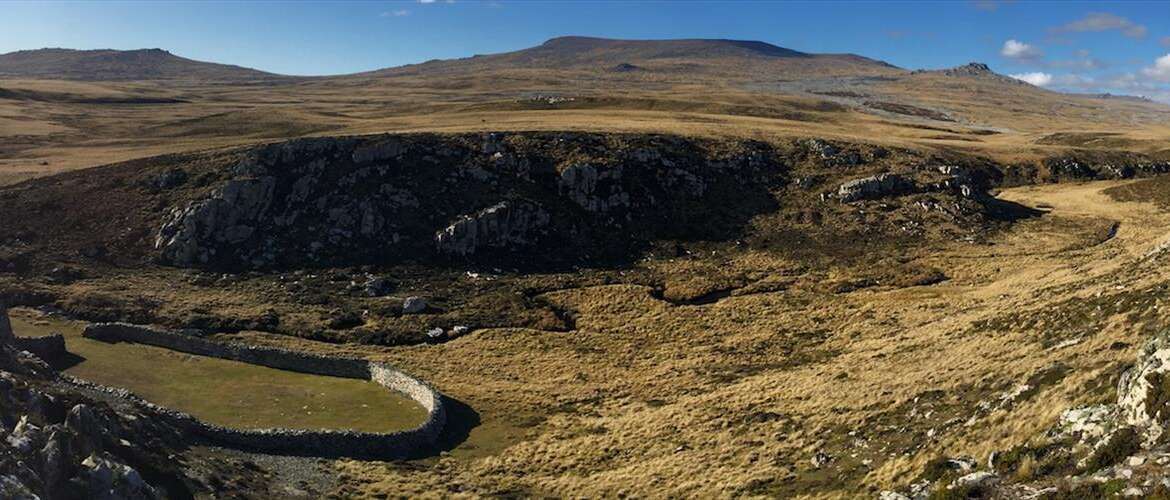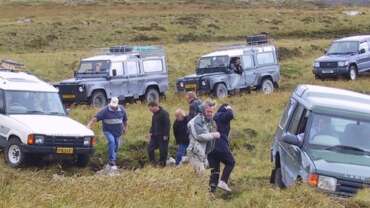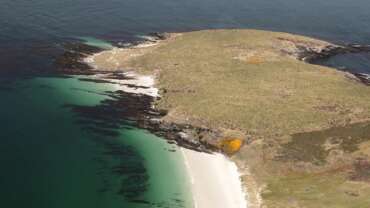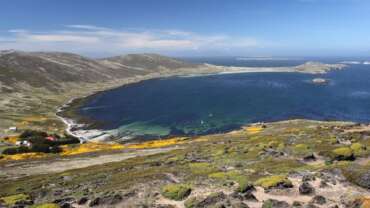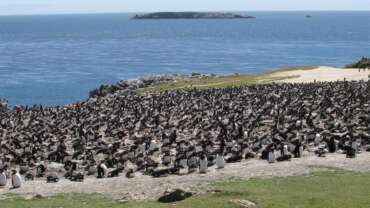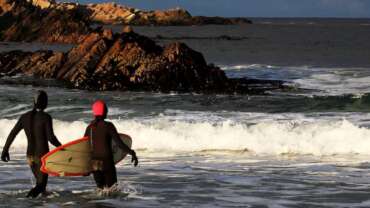Attractions in Falkland Islands
The unspoiled environment of the Falkland Islands is a must-visit for anyone with a yearning to discover an off-the-beaten-track pristine destination.
Incomparable and abundant wildlife
Wildlife encounters are amazing. Marvel at the sparring of male elephant seals or the majestic black-browed albatross in flight. Enjoy the antics of penguins in their colonies, squabbling raucously with their neighbours, stealing nesting materials, or simply sitting silently to soak up the sun. Many experiences are guaranteed during summer months as birds and marine mammals have established colonies at locations around the islands. Sightings of whale pods and blows, rare visitors or other notable happenings are always shared amongst Islanders and visitors alike.
Glorious landscapes, beaches, skies
The landscapes themselves, from rugged rocky coastlines to spectacular white sand beaches, boulder-scattered hills to sweeping open plains, magnificent stone runs to picturesque settlements, all set against a backdrop of ever-changing big skies are a beauty to behold.
Fabled history and traditions
The Falklands have a rich history from the days of early settlement including stone corrals and pioneer cottages through involvement in both world wars and to the establishment of economic activities that support the current development of the Islands. The Historic Dockyard Museum in Stanley is an excellent place to discover aspects of Falkland life both past and present.
Some visitors arrive in the Islands to learn more about the 1982 war. Many monuments and memorials, along with museums and other memorabilia can be found in settlements across East and West Falkland and some of the smaller islands
Get away from it all
But one of the main attractions of a visit to the Falklands is to simply absorb the pace and opportunities of Island life. Enjoy the incredible experience of a stay on a remote island with just a handful of permanent human inhabitants, arriving in style on a small aircraft to a personal meet-and-greet at the airstrip. Islanders are renowned for their hospitality including hearty home-cooked meals and delicious baking. It is an experience that you will never forget.
Birds & Sealife
The Falkland Islands are the ultimate birding experience with large, easily accessible colonies of some of the world’s rarest and most enchanting birds. There are plenty of species for the amateur birder and the enthusiast alike.
A birder’s paradise
Best known for penguins, the antics of these birds never fail to delight both at sea and on shore. Majestic king, feisty rockhopper, raucous gentoo and shy magellanic penguins are easy to find with the more elusive macaroni penguin and even hybrids blending into rockhopper colonies in some locations.
Over 70% of the world’s black-browed albatross breed around the islands. Magnificent in flight, clumsy when landing but elegant in appearance, the albatross is a stunning photographic study.
Other striking seabirds include the southern giant petrel which also sweeps majestically along the shores, storm petrels and diving petrels. Rock cormorants and imperial cormorants breed in the Islands, skuas and gulls are plentiful, terns can be seen in some locations. Oystercatchers, plovers and kelp geese inhabit many shores. Black-crowned night herons pick their way carefully and quietly along the water’s edge, often sheltering under old jetties and shipwrecks.
These are just a few of the birds you will find here on the Falklands. Endemic species are the Cobb’s wren, found on a number of small islands, and the Falklands’ Flightless Steamer Duck with its distinctive call. The striking Southern Caracara has colourful plumage but it’s the inquisitive nature of the Striated Caracara that will bring this bird to your attention!
Mammals in the ocean
The Islands are home to sea lions, fur seals and the world’s largest pinniped, the elephant seal. Dolphins play in the surf and love to follow boats. Orcas are frequently seen along the coast of Sea Lion Island, on the look-out for their next meal.
Wildlife experiences are guaranteed and with only a few visitors in many locations, the up-close-and-personal experience is second to none.
Epic Landscapes
The Falkland Islands are a pristine landscape of endless horizons, colours and contrasts with stunning seascapes to match. There is plenty of space and scenery to enjoy.
Bursting with colour
Subtle hues of greens and yellows, boulder-strewn hills and tiny red-and-white settlements nestling into the land create beautiful vistas. Shimmering seas reflect the sun in an amazing array of brilliant blues and aqua-marines. Kelp forests twist and turn, in shades of subdued browns and greens, as they follow the ebb and flow of ocean currents. All set against a backdrop of ever-changing skies, from brilliant daytime blues to reds, crimsons and golds of the setting sun.
Rugged vistas
The offshore islands to the west of the archipelago are characterised by jagged cliff tops and rugged peaks, some dropping steeply, others sweeping down to long white sand beaches, inviting coves and boulder-strewn shores. Large ponds are features of open plains. Rocky outcrops and small tussac islands dot the coastline. Contrast these with small islands to the east which are flatter but no less scenic with open land and magnificent seashores.
Glorious seascapes
West Falkland has both rugged and rolling terrain with a mix of spectacular cliffs, hills, hidden valleys and flat lakelands. In the south are rock formations known as “Indian Village” due to their unusual wig-wam shapes. Impressive stone runs are found on East Falkland. These rivers of rock tumble down the hillsides, some stream-like, others very wide. Travel south in East Falkland to the Great Plain of Lafonia for miles and miles of uninterrupted golden grasslands. Both East and West boast beautiful beaches and lovely shores.
Stop awhile to watch the changing patterns and colours of the seas. Admire the shifting light as the sun sets, casting a range of hues across the hills. The Falklands are a great place to simply relax and enjoy the views.
History & Heritage
The Falkland Islands have a rich history embracing geological features, some famous visitors, maritime adventures, farming traditions and of course the events of the 1982 war. There is much to discover.
A naturalist’s wonder
Rocks and fossils tell a fascinating story dating back one billion years; the most interesting and unusual feature being stone runs, rivers of rock cascading out of the mountains to the valley floor. Stone runs are found on East Falkland, easy to view from the roadside but at their most spectacular when seen from above! The naturalist Charles Darwin spent longer on the Falklands than the Galapagos Islands and his world-changing theories were based on his discovery of a wolf-like animal called the Warrah, sadly now extinct, and his fossil-finds.
Early settlers
Stone corrals and turf walls were constructed by early settlers in the Islands and splendid examples can still be explored at Darwin and Stanley. Stone buildings survive at a number of locations, though later houses were built from wood due to the ease and cost of importation of light-weight materials.
Pioneer cottages on Drury Street and Pioneer Row are now mainly privately-owned houses but can be seen and photographed on a guided or self-guided tour of the Islands’ capital. Cartmell Cottage, on Pioneer Row, is owned by the Falkland Islands Museum and National Trust and open to visitors. It depicts life at various points in time through donated exhibits.
Maritime tradition
Over one hundred ships have been wrecked off Falkland shores, due to gales and hidden rocks. The Lady Elizabeth survives at the eastern end of Stanley harbour and a few remains can be found elsewhere around the Islands. A mizzen mast from the SS Great Britain is displayed on Victory Green in Stanley. Artefacts from some of the ships and interesting anecdotes are in the Historic Dockyard Museum. Cape Pembroke Lighthouse, at the extreme eastern end of the Stanley peninsula is another reminder of times past.
Farm life
Farming heritage is on display at the excellent little museum at North Arm as well as through memorabilia at the Historic Dockyard Museum. Travel around the Islands, in summer months particularly, gives an insight into continuing, daily farm life with opportunities to view sheep shearing and through conversations with farm workers.



